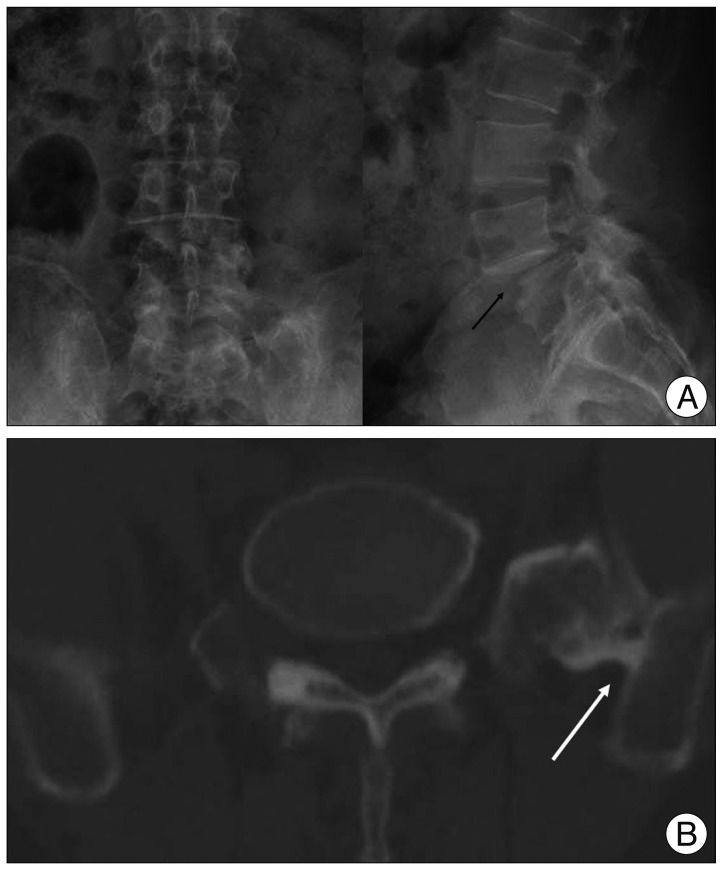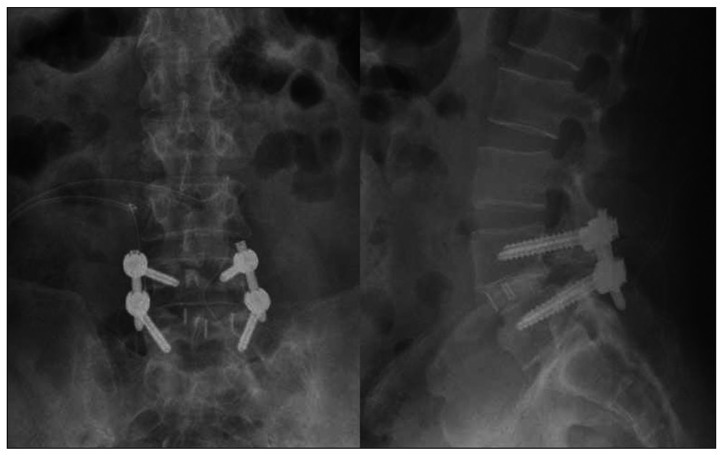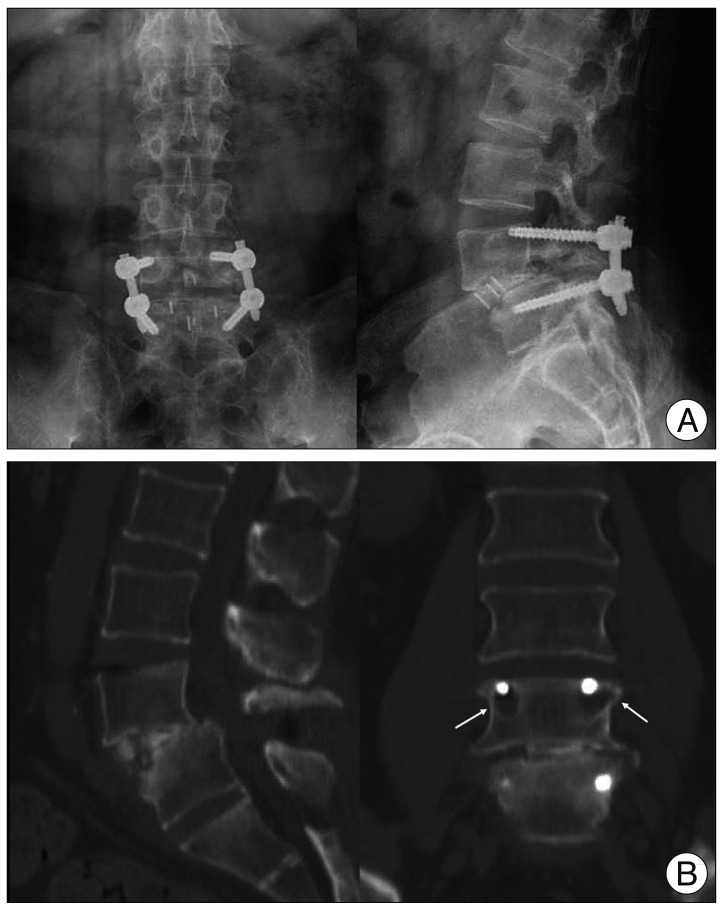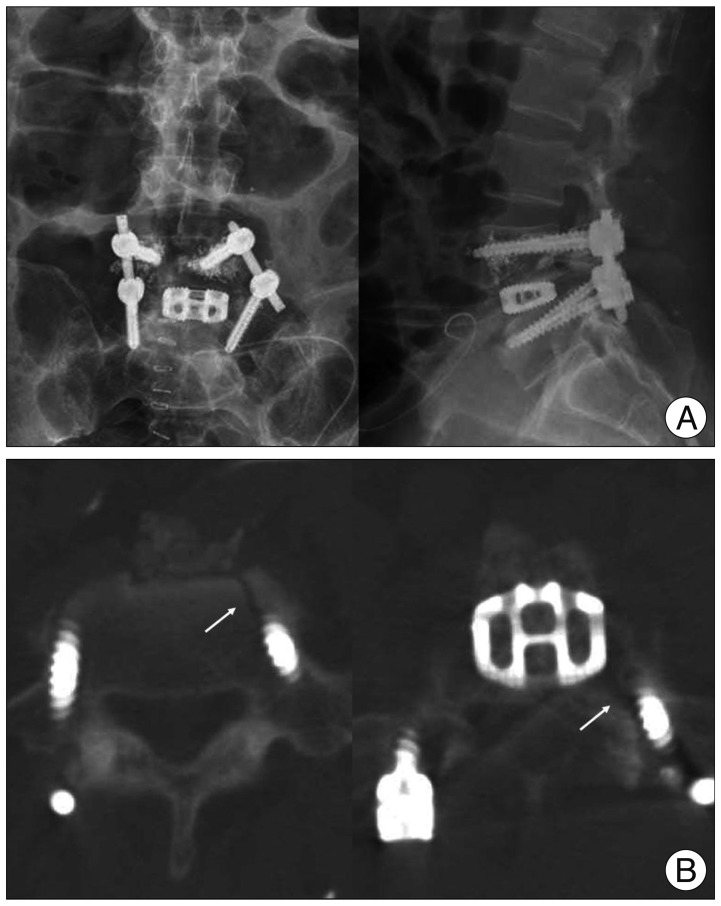J Korean Neurosurg Soc.
2013 Aug;54(2):128-131. 10.3340/jkns.2013.54.2.128.
Anterior Dislodgement of a Fusion Cage after Transforaminal Lumbar Interbody Fusion for the Treatment of Isthmic Spondylolisthesis
- Affiliations
-
- 1Department of Neurosurgery, Busan Wooridul Spine Hospital, Busan, Korea.
- 2Department of Neurosurgery, Seoul Wooridul Spine Hospital, Seoul, Korea.
- 3Department of Orthopaedic Surgery, Spine Love Hospital, Goyang, Korea. busan@wooridul.co.kr
- KMID: 1814250
- DOI: http://doi.org/10.3340/jkns.2013.54.2.128
Abstract
- Transforaminal lumbar interbody fusion (TLIF) is commonly used procedure for spinal fusion. However, there are no reports describing anterior cage dislodgement after surgery. This report is a rare case of anterior dislodgement of fusion cage after TLIF for the treatment of isthmic spondylolisthesis with lumbosacral transitional vertebra (LSTV). A 51-year-old man underwent TLIF at L4-5 with posterior instrumentation for the treatment of grade 1 isthmic spondylolisthesis with LSTV. At 7 weeks postoperatively, imaging studies demonstrated that banana-shaped cage migrated anteriorly and anterolisthesis recurred at the index level with pseudoarthrosis. The cage was removed and exchanged by new cage through anterior approach, and screws were replaced with larger size ones and cement augmentation was added. At postoperative 2 days of revision surgery, computed tomography (CT) showed fracture on lateral pedicle and body wall of L5 vertebra. He underwent surgery again for paraspinal decompression at L4-5 and extension of instrumentation to S1 vertebra. His back and leg pains improved significantly after final revision surgery and symptom relief was maintained during follow-up period. At 6 months follow-up, CT images showed solid fusion at L4-5 level. Careful cage selection for TLIF must be done for treatment of spondylolisthesis accompanied with deformed LSTV, especially when reduction will be attempted. Banana-shaped cage should be positioned anteriorly, but anterior dislodgement of cage and reduction failure may occur in case of a highly unstable spine. Revision surgery for the treatment of an anteriorly dislodged cage may be effectively performed using an anterior approach.
Keyword
MeSH Terms
Figure
Reference
-
1. Abbushi A, Cabraja M, Thomale UW, Woiciechowsky C, Kroppenstedt SN. The influence of cage positioning and cage type on cage migration and fusion rates in patients with monosegmental posterior lumbar interbody fusion and posterior fixation. Eur Spine J. 2009; 18:1621–1628. PMID: 19475436.
Article2. Aihara T, Takahashi K, Ogasawara A, Itadera E, Ono Y, Moriya H. Intervertebral disc degeneration associated with lumbosacral transitional vertebrae : a clinical and anatomical study. J Bone Joint Surg Br. 2005; 87:687–691. PMID: 15855373.3. Castellvi AE, Goldstein LA, Chan DP. Lumbosacral transitional vertebrae and their relationship with lumbar extradural defects. Spine (Phila Pa 1976). 1984; 9:493–495. PMID: 6495013.
Article4. Cho W, Wu C, Mehbod AA, Transfeldt EE. Comparison of cage designs for transforaminal lumbar interbody fusion : a biomechanical study. Clin Biomech (Bristol, Avon). 2008; 23:979–985.
Article5. Elster AD. Bertolotti's syndrome revisited. Transitional vertebrae of the lumbar spine. Spine (Phila Pa 1976). 1989; 14:1373–1377. PMID: 2533403.6. Foley KT, Holly LT, Schwender JD. Minimally invasive lumbar fusion. Spine (Phila Pa 1976). 2003; 28(15 Suppl):S26–S35. PMID: 12897471.
Article7. Fukuta S, Miyamoto K, Hosoe H, Shimizu K. Kidney-type intervertebral spacers should be located anteriorly in cantilever transforaminal lumbar interbody fusion : analyses of risk factors for spacer subsidence for a minimum of 2 years. J Spinal Disord Tech. 2011; 24:189–195. PMID: 20634726.
Article8. Grant JP, Oxland TR, Dvorak MF. Mapping the structural properties of the lumbosacral vertebral endplates. Spine (Phila Pa 1976). 2001; 26:889–896. PMID: 11317111.
Article9. Humphreys SC, Hodges SD, Patwardhan AG, Eck JC, Murphy RB, Covington LA. Comparison of posterior and transforaminal approaches to lumbar interbody fusion. Spine (Phila Pa 1976). 2001; 26:567–571. PMID: 11242386.
Article10. Kettler A, Schmoelz W, Kast E, Gottwald M, Claes L, Wilke HJ. In vitro stabilizing effect of a transforaminal compared with two posterior lumbar interbody fusion cages. Spine (Phila Pa 1976). 2005; 30:E665–E670. PMID: 16284577.
Article11. Kim NH, Suk KS. The role of transitional vertebrae in spondylolysis and spondylolytic spondylolisthesis. Bull Hosp Jt Dis. 1997; 56:161–166. PMID: 9361917.12. Kiner DW, Wybo CD, Sterba W, Yeni YN, Bartol SW, Vaidya R. Biomechanical analysis of different techniques in revision spinal instrumentation : larger diameter screws versus cement augmentation. Spine (Phila Pa 1976). 2008; 33:2618–2622. PMID: 19011543.
Article13. Konin GP, Walz DM. Lumbosacral transitional vertebrae : classification, imaging findings, and clinical relevance. AJNR Am J Neuroradiol. 2010; 31:1778–1786. PMID: 20203111.
Article14. Lauber S, Schulte TL, Liljenqvist U, Halm H, Hackenberg L. Clinical and radiologic 2-4-year results of transforaminal lumbar interbody fusion in degenerative and isthmic spondylolisthesis grades 1 and 2. Spine (Phila Pa 1976). 2006; 31:1693–1698. PMID: 16816765.
Article15. Lowe TG, Tahernia AD, O'Brien MF, Smith DA. Unilateral transforaminal posterior lumbar interbody fusion (TLIF) : indications, technique, and 2-year results. J Spinal Disord Tech. 2002; 15:31–38. PMID: 11891448.
Article16. Lund T, Oxland TR, Jost B, Cripton P, Grassmann S, Etter C, et al. Interbody cage stabilisation in the lumbar spine : biomechanical evaluation of cage design, posterior instrumentation and bone density. J Bone Joint Surg Br. 1998; 80:351–359. PMID: 9546475.17. McCord DH, Cunningham BW, Shono Y, Myers JJ, McAfee PC. Biomechanical analysis of lumbosacral fixation. Spine (Phila Pa 1976). 1992; 17(8 Suppl):S235–S243. PMID: 1523506.
Article18. Ngu BB, Belkoff SM, Gelb DE, Ludwig SC. A biomechanical comparison of sacral pedicle screw salvage techniques. Spine (Phila Pa 1976). 2006; 31:E166–E168. PMID: 16540856.
Article19. Nguyen HV, Akbarnia BA, van Dam BE, Raiszadeh K, Bagheri R, Canale S, et al. Anterior exposure of the spine for removal of lumbar interbody devices and implants. Spine (Phila Pa 1976). 2006; 31:2449–2453. PMID: 17023854.
Article20. Pawar UM, Kundnani V, Nene A. Major vessel injury with cage migration : surgical complication in a case of spondylodiscitis. Spine (Phila Pa 1976). 2010; 35:E663–E666. PMID: 20505562.21. Proubasta IR, Vallvé EQ, Aguilar LF, Villanueva CL, Iglesias JJ. Intraoperative antepulsion of a fusion cage in posterior lumbar interbody fusion : a case report and review of the literature. Spine (Phila Pa 1976). 2002; 27:E399–E402. PMID: 12221375.22. Taneichi H, Suda K, Kajino T, Matsumura A, Moridaira H, Kaneda K. Unilateral transforaminal lumbar interbody fusion and bilateral anterior-column fixation with two Brantigan I/F cages per level : clinical outcomes during a minimum 2-year follow-up period. J Neurosurg Spine. 2006; 4:198–205. PMID: 16572618.
Article
- Full Text Links
- Actions
-
Cited
- CITED
-
- Close
- Share
- Similar articles
-
- Anterior Cage Migration during Transforaminal Lumbar Interbody Fusion: A Case Report and Review of the Literature
- Posterior Lumbar Interbody Fusion and Graf Band Fixation for Lumbar Isthmic Spondylolisthesis
- Uniportal Endoscopic Lumbar Interbody Fusion
- Effect of Posterior Lumbar Interbody Fusion for Maintaining the Reduction in Isthmic Spondylolisthesis
- Surgical Treatment of Isthmic Spondylolisthesis: Pedicle Screw Fixation, Posterolateral Fusion, and Posterior Lumbar Interbody Fusion with Cage after Wide Decompression






